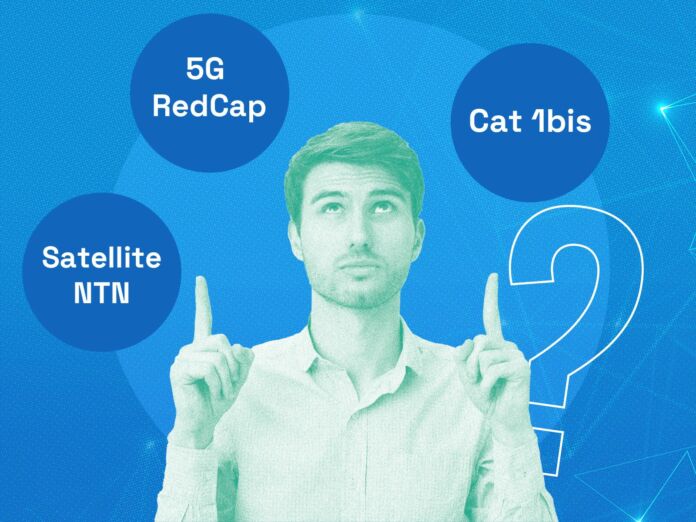
By Velocity IoT – May 27, 2024
Collected at : https://www.iotforall.com/cat-1bis-5g-redcap-satellite-ntn-which-should-you-choose
The landscape of IoT connectivity is dynamically changing, with older technologies like 2G/3G being phased out and newer ones emerging. Choosing the right connectivity technology and provider is crucial for the success of IoT projects. Three connectivity technologies generating buzz are Cat 1bis, 5G RedCap, and Satellite NTN.
Cat 1bis Explained
LTE, or “Long-Term Evolution,” is part of the 4G communication standards developed under 3GPP Release-8. The 4G LTE family includes various categories: LTE Cat 4, LTE Cat 1, LTE Cat M1 (LTE-M), LTE Cat NB1 (NB-IoT), and LTE Cat 1bis.
LTE Cat 1bis is a refined version of LTE Cat 1. Utilizing the same infrastructure and standards but simplified to a single-antenna configuration. This modification reduces costs and improves power efficiency, making it economically and environmentally favorable. Cat 1bis maintains all the features and capabilities of LTE Cat 1, ensuring no loss in functionality. While it might have slightly reduced coverage compared to dual-antenna Cat 1, this difference seldom affects the overall user experience.

Benefits and Use Cases of Cat 1bis
Cat 1bis is ideal for devices requiring faster connectivity than LTE-M but slower than full LTE Cat 1 speeds. It suits massive IoT applications like asset tracking, logistics, telematics, metering, and smart cities. It supports Power Saving Mode (PSM) and extended Discontinuous Reception (eDRX), enhancing device battery life. The design is simpler, more compact, and cost-effective, leveraging the widespread LTE Cat 1 infrastructure for reliable coverage.
5G Explained
5G, the fifth generation of cellular technology, offers higher data rates, lower latency, and more reliable connections compared to previous generations. It supports enhanced Mobile Broadband (eMBB), ultra-Reliable Low Latency Communication (uRLLC), and massive Machine-Type Communication (mMTC). This enables applications from autonomous vehicles to smart cities.
5G NSA (Non-Standalone) and 5G SA (Standalone)
5G NSA: 5G NSA builds on existing 4G LTE infrastructure, facilitating a quicker and more cost-effective rollout of 5G services. It enhances data speeds and network capacity while leveraging the existing 4G core. However, it may limit some advanced 5G capabilities. This makes 5G NSA ideal for applications like high-definition video streaming, VR, wearable devices, healthcare asset tracking, and smart homes. The approach enables faster deployment and reduced costs, enhancing mobile broadband experiences in urban areas.
5G SA: 5G SA operates independently of 4G LTE, using a new 5G core network. This model supports advanced features like network slicing, ultra-low latency communication, and massive device connectivity, unlocking the full potential of 5G technology. With its full capabilities, 5G SA is suitable for autonomous vehicles, smart factories, and advanced IoT applications that require reliable, low-latency connections. It is also ideal for real-time remote control and monitoring in industries such as manufacturing and healthcare. Although 5G SA offers superior performance, it is more time-consuming and costly to deploy due to the need for new infrastructure.
Understanding the benefits and use cases of 5G NSA and SA helps organizations align their IoT projects with the appropriate 5G deployment model, ensuring optimal performance.
5G RedCap (5G NR-Light)
5G RedCap, also known as 5G NR-Light, is a simplified version of 5G for IoT applications needing better performance than 4G but not the full capabilities of 5G. Introduced with 3GPP Release 17, it offers sufficient bandwidth and lower latency while reducing complexity and cost.
5G RedCap provides lower complexity and cost with improved performance over 4G. It offers sufficient bandwidth and latency for medium-demand applications but does not have the full capabilities of 5G, making it suitable for specific IoT use cases like industrial sensors, smart agriculture, and enhanced wearables.
What is Satellite NTN?
Non-Terrestrial Networks (NTN) refer to communication systems that extend beyond terrestrial infrastructure. They utilize satellites in Low Earth Orbit (LEO), Medium Earth Orbit (MEO), and Geostationary Orbit (GEO). 3GPP Release 17 enables standard cellular devices to access both GEO and LEO satellites. They use NR-NTN for 5G New Radio and IoT-NTN for LPWA IoT applications via NB-IoT and LTE-M. This development promises ubiquitous coverage, addressing gaps in cellular network reach, especially in rural and remote areas.
Traditional satellite communications required specialized, costly hardware. Release 17 allows standard cellular hardware to achieve satellite connectivity, reducing costs and simplifying deployment. This standardization encourages innovative satellite IoT applications and business models.
Use Cases
With only 15% of the world covered by cellular, any remote use case benefits from this hybrid approach:
- Maritime: Ships can maintain reliable connections through dual-mode technology, improving navigation, safety, and communication with onshore operations.
- Agriculture: In rural farmlands, dual-mode devices can help monitor crop health, soil conditions, and livestock movements ensuring uninterrupted data flow, enabling precision farming practices.
- Energy & Utilities: For remote assets like wind turbines, dual-mode connectivity allows utilities to use cellular networks primarily, switching to satellite during disasters or disruptions, ensuring reliable communication.
Choosing the Right Connectivity Solution
As IoT continues to evolve, selecting the right connectivity option becomes increasingly critical. Carefully considering the specific requirements of your IoT project and aligning them with the appropriate technology and provider is essential for ensuring a successful, future-proof deployment.
In the rapidly evolving IoT world, partnering with a network provider that supports the latest technologies and offers scalability, reliability, and comprehensive support is key. Technologies such as eSIM, multi-IMSI, and eUICC can help address connectivity challenges. For instance, Velocity IoT’s smart connectivity solution leverages multi-IMSI and eUICC technologies, allowing for remote SIM provisioning. This flexibility ensures devices remain connected across different networks and regions, adapting to the best available connectivity options and flexibility of adding new technologies when available.
Embracing new technologies is crucial, but there’s no immediate rush to abandon 4G. 4G remains a robust and reliable option for many applications. By focusing on selecting the right connectivity solutions that offer both current reliability and future readiness, you can ensure your IoT deployments remain adaptable, resilient, and innovative in a rapidly changing technological landscape.

Leave a Reply